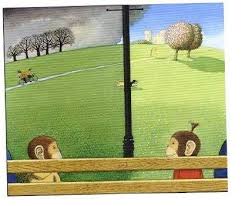As I embark on a new endeavor of becoming a blogger, I can’t help but be reminded of this video.
So in the words of this 4th grader…“Here….I….Go!”
Let’s talk about Mastery Learning…
“Students should adequately comprehend a given concept before being expected to understand a more advanced one.” (page 37). Mastery learning is, “predicated on the belief that all students could learn if provided with conditions appropriate to their needs,” and is a, “curriculum not [focused] in terms of time, but in terms of certain target levels of comprehension and achievement.” Well that seems simple. Even Khan says it, “seems straightforward and commonsensical enough.” (page 37).
This leads me to 2 questions:
- Why hasn’t mastery learning been the focus of our educational system?
Simple answer, in my opinion, FEAR & UNCERTAINTY.
2. What is Khan’s message to us about mastery learning?
Again, in my opinion, PARADIGM SHIFT & JOY.
Voices in the Park
Ok so I am going to digress a little, but I promise I will make it count as I dive into the contents of this chapter while comparing it to a children’s book. When I read about mastery learning, I don’t know why, but a specific book kept coming to mind. A wonderful children’s book, which if you haven’t read or used in your class you MUST, titled Voices in the Park. Now how does this book relate to the concept of mastery learning? Let’s take a closer look.
Voices in the Park is broken into four different voices, each being a different character’s perspective of the same event. The pictures are an important part of understanding each character. I will use each voice to try to answer the questions stated above, in more detail, about why mastery learning hasn’t found its place in education and how Khan sees mastery learning in our future. Fear, Uncertainty, Paradigm Shift, and Joy.
If you haven’t read this book please use this link to familiarize yourself before continuing.
THE 1st VOICE: FEAR
The first voice is a mother. She is conservative and traditional. This mother is rigid and strict. She lives her life in fear of change and of anything and anyone that is different from the bubble in which she lives in. She controls her son and does not allow him or their dog to stray from her control and when this happens FEAR overcomes her. She feels out of control and is unable to focus until everything is back in its perfect place.

Now let’s see how this fits with mastery learning. In this chapter Khan says, “Change was difficult; change was frightening. The old way worked well enough,” (page 41). He continues to talk about how, “Human nature hasn’t changed,” (page 41) because, “People in all fields still have a tendency to protect their turf, sometimes at the expense of the greater good.” (page 42). Sound familiar? The fear of change this mother felt is the same fear that many of us feel when new educational reform emerges such as mastery learning. Perhaps this is why it has never fully taken root.
THE 2nd VOICE: UNCERTAINTY
The second voice is a dad who is down on his luck. He is disappointed with his current predicament of not having a job and is UNCERTAIN that anything will help, but he holds on to a sliver of hope. He begins to feel better by the presence of his joyful daughter.

I hope you’re beginning to see what I saw when I was reading this chapter. This dad represents our uncertainty in making a change. Currently, “personal responsibility is not only undervalued but actually discouraged by the standard classroom model, with its enforced passivity and rigid boundaries of curriculum and time. Denied the opportunity to make even the most basic decisions about how and what they will learn, students stop short of full commitment.” (page 43). This isn’t very encouraging. I think that Khan is arguing that mastery learning is our small sliver of hope that things can get better even if we are uncertain that it will help and that it will work.
THE 3rd VOICE: PARADIGM SHIFT
The third voice is the son of the first voice. This boy is timid and quiet. He lives in fear of his mother and of upsetting her so he does his best not to rock the boat by obeying her. But then a girl comes along and he sees an opportunity to try something new even though he is reluctant at first. The more he plays with this girl the more he starts to CHANGE and begins to see the world a little differently.

Although we are fearful and uncertain, what might happen to education if we begin to see that mastery learning is possible? What impact might this have on educators and students? Khan reminds us that with our changing world we now have the resources available to make mastery learning work and for it to be effective.
Mastery learning is not a totally new concept. It was first introduced in Winnetka, Illinois by Carleton W. Washburne in 1922 as the Winnetka Plan. This was a “radical concept” in which, “Students, with the help of self-paced exercises, proceed at varying rates toward the same level of mastery.” (pages 38-39). But soon after its introduction this idea of mastery learning, “Went out of vogue, and for years-for decades-it was all but forgotten.” (page 39). I think that our fear and uncertainty may have caused this and what we are in need of is a paradigm shift, much like this little boy.
With mastery learning we have an opportunity to, “develop more positive attitudes about learning and about [students’] ability to learn.” (page 43). The paradigm shift needed here is to focus on the importance of students fully comprehending concepts at their own pace rather than moving on just to move on because it is time.
THE 4th VOICE: JOY
The fourth voice is a young girl who doesn’t have much, but sees the world as a colorful place full of wonder and opportunity. She is bold and JOYFUL and doesn’t shy away from a challenge. Taking risks and exploring is what she does best. When she meets the little boy in the park she encourages him to try something new and find JOY in his boring life.

I think that we all have an opportunity to experience this type of joy within education and take a risk in experimenting with mastery learning in order to provide students with the same opportunity of experiencing joy in learning. Sal refers to a study where, “It was observed that students in mastery programs ‘developed more positive attitudes about learning and about their ability to learn.” (page 43). To me, Sal Khan is like this little girl. He sees learning differently and is trying to help us all experience joy. Mastery learning is just one small step in the right direction.
Thanks for reading!
Larissa

Larissa,
I applaud your usage of the video as well as the voices! You are a natural writer. These chapters are related to adult and student learning. The concept of mastery is part of a process. Often I fear that we as adults expect that we will be masters automatically and that we will not need a process.
The journey is where the action is and the journey is full of voices as you write as well as ups and downs.
Thank you for your contribution to the book study. I enjoy this book and I really enjoy reading your words, those of your colleagues as well as the comments.
Sincerely,
Mike
Thank you! I agree teaching in and of itself is a journey and I hope to make my journey one that is full of adventure and excitement and definitely JOY!
Great post, Larissa and I love the comparison to the 4 voices in the children’s book. Fear and Uncertainty are certainly reasons that mastery learning didn’t maintain the hold it began with in Winnetka. (I always wondered who that middle school in the town next door to where I grew up was named after….).
I also think that going hand in hand with fear and uncertainty is that age old explanation of “But, but, but….we’ve always done it this way!” What have we always done? Had a curriculum that was geared toward the middle…you teach it and then you move on. Some won’t get it and some will be bored. That is the way it goes. But yet, not! Knowing what we know now and having access to the resources and technology and knowledge of BETTER teaching we can do better. This type of learning does bring joy. And what is better than being the witness and guide for that? Nothing. 🙂
Move over Sal Khan, because Larissa Thurman just knocked Mastery Learning out of the park! I never would have thought about using Voices in the Park to explain mastery learning, but you really made it relevant with your descriptions. Well done!
The voices of fear and uncertainty reflect how many people feel about changing the “norm” or trying something different. I think it’s interesting that both of these voices are adults. I think we have learned over the years to be afraid of change and shy away from things that make us uncomfortable or seem too difficult.
The voices of paradigm shift and joy though, come from children. They haven’t had as much experience with change and failure, so they are more willing to jump in. Being in the business of educating children means we should learn from them just as much as they learn from us. And if mastery learning can bring more joy into the classroom, then what are we waiting for? Embrace the joy!
Caitlin,
I love that you relate the joy to our children! I also think this is the reason we need to allow them to lead and make choices. We have so much to learn from our children and from watching our children bravely learn and experience.
It is always a joy to watch learning happen through their eyes!
Svetlana
YES! I didn’t notice that, but it is SO true. The adult perception versus the kid perception. Brillant!
I really loved this comparison Larissa! I keep going back to the quote you mentioned at the beginning, “curriculum not [focused] in terms of time, but in terms of certain target levels of comprehension and achievement.” I think, as adults, we often are consumed with the idea of time as we know how important and valuable it is. That quote is a great reminder that we have to try and let go of some of the day-to-day or week-to-week constraints we place on ourselves and find joy in letting the students lead the way!
Larissa,
First of all great post. Welcome to the world of blogging. I love the connection to Voices in the Park – great book.
I love this chapter. It is neat to think that right down the road from us in Deerfield is where this concept first took root in our current education system. It is exciting now to be having discussions about it again.
It is such a simple yet powerful tweak to think of curriculum not in terms of time but in terms of targets. I think that is what has been exciting about our approach to our curriculum maps and the CCSS.
Larissa,
First of all, great job on the post! I loved how you used the book! 🙂 Second of all, your post and this chapter made me really reflect on my own fears and how we as teachers, need to embrace these fears of change to help our students be more successful. I think that in the past two years we have really pushed our fears away, in order to do what is best for our students in the classroom. There have been so many changes and so many amazing opportunities to use resources and tools that we have never used before. I think that with these changes, we have embraced the joy of teaching and learning daily!
I also wanted to mention a section of this chapter where it talked about taking responsibility of the learning. I love when Khan said, “taking responsibility for learning is learning.” Students need to find the joy in learning and take personal responsibility for mastering skills and standards. We need to encourage our students, no matter what age, to take responsibility in growing their knowledge and skills. Like Khan, I think that having a 1:1 environment at our school really provides students the opportunity to be more responsible in their individualized learning, and I want to keep encouraging students to track their learning in order to grow. We have started to help our students take more ownership using the Leadership binders this year, so I am excited to see how this emphasis on responsibility will help our students to be more successful academically, emotionally, and socially.
Amazing post Larissa! Let the blogging begin!
Anthony Brown is my favorite children’s author and this book was a perfect pairing for this chapter!
When I was going through elementary school, we had a mastery learning ‘program’ called SRA Reading Laboratory kit from McGraw Hill that was all the rage. I remember being so excited to choose my own color tab and reading passage and passing the assessment at the end to see if I can continue to the next level. It was everything Sal describes as personalized and mastery learning with the ownership of learning on the student.
The fear, I feel, comes from wanting control and compliance from our students. Control and compliance in education assures equity in learning across grade levels and for the system as a whole but we take it too far when we take the learning and choice away from the students.
So proud that we are on the forefront of making this paradigm shift for our students!
YES! Letting go of control is such a scary thing! But how incredible it is when we take away the ceiling from our students and let them flourish and explore things we didn’t think they were capable of. It’s an amazing thing!
Terrific post Larissa! I love the book, Anthony Browne, and how you used the theme in each character’s voice to relate it to Mastery Learning. I have used the book to teach writers to use different voices with four characters they created. I think having a theme tied to each character’s part in the story would add a great deal to that activity. You inspired me to add another level of challenge when I assign that activity again. Thank you.
Larissa,
WOW! Here …you …goooooo!!! Seriously so impressed with your blogging skills! I LOVED the connection you made to the four voices. Like Caitlin, I also thought how relevant it was that the adult voices were the ones of fear and uncertainly and the children’s of paradigm shift and joy. Thank goodness for the children and everything they teach us! I always marvel at the fearlessness of children and how they just find joy everywhere. I also thought it was so cool that the birth of mastery learning was just a few miles from our school. As I read this chapter one connection I made was to some of the programs I use with the students I teach. One of those programs is the Wilson Reading Program. I am currently using this program with several of my struggling readers and writers. Wilson is a structured, phonics program with a strong multi-sensory component. One of the most important parts of this program, is that the students are not able to move on in the program without mastering each step. They must master each step’s rule(s) both in encoding and decoding before they move on to the next step or rule. I have seen such success and progress with this program. I believe that the mastery component is a huge reason this program works. If this type of mastery learning works with our most struggling learners, I would love to see where it would take all of our learners.